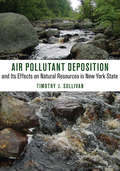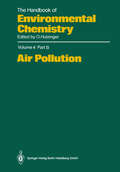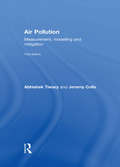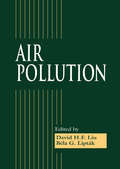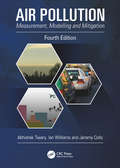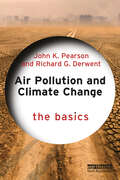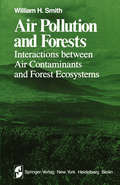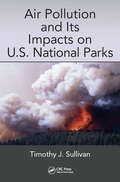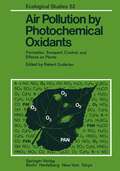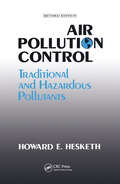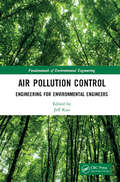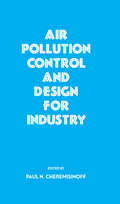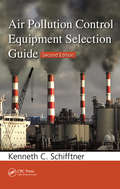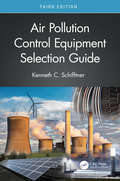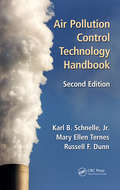- Table View
- List View
Air Plants: The Curious World of Tillandsias
by Zenaida SengoKnown for their spiky shape and extremely low-maintenance needs, air plants are growing increasingly popular for crafting, design, and décor. Because they don&’t need soil, you can learn the best tips and tricks in Air Plants to dangle and perch tullandsias almost anywhere in your home.
Air Pollutant Deposition and Its Effects on Natural Resources in New York State
by Timothy J. SullivanEcosystem effects from air pollution in the Adirondacks, Catskills, and elsewhere in New York have been substantial. Efforts to characterize and quantify these impacts, and to examine more recent recovery, have focused largely on surface waters, soils, and forests. Lakes, streams, and soils have acidified. Estuaries have become more eutrophic. Nutrient cycles have been disrupted. Mercury has bioaccumulated to toxic levels. Plant species composition has changed. Some surface waters show signs of partial chemical recovery in response to emissions control programs, but available data suggest that soil chemistry may continue to deteriorate under expected future emissions and deposition. Resource managers, policymakers, and scientists now need to know the extent to which current and projected future emissions reductions will lead to ecosystem recovery.In this book, Timothy J. Sullivan provides a comprehensive synthesis of past, current, and potential future conditions regarding atmospheric sulfur, nitrogen oxides, ammonium, and mercury deposition; surface water chemistry; soil chemistry; forests; and aquatic biota in New York, providing much needed information to help set emissions reduction goals, evaluate incremental improvements, conduct cost/benefit analyses, and prioritize research needs. He draws upon a wealth of research conducted over the past thirty years that has categorized, quantified, and advanced understanding of ecosystem processes related to atmospheric deposition of strong acids, nutrients, and mercury and associated ecosystem effects. An important component of this volume is the new interest in the management and mitigation of ecosystem damage from air pollution stress, which builds on the "critical loads" approach pioneered in Europe and now gaining interest in the United States. This book will inform scientists, resource managers, and policy analysts regarding the state of scientific knowledge on these complex topics and their policy relevance and will help to guide public policy assessment work in New York, the Northeast, and nationally.
Air Pollution (The Handbook of Environmental Chemistry #4 / 4B)
by H. Brauer J. S. Gaffney R. Harkov M.A.K. Khalil F. W. Lipfert N. A. Marley E. W. Prestbo G. E. ShawAn important purpose of The Handbook of Environmental Chemistry is to aid the understanding of distribution and chemical reaction processes which occur in the environment. Volume 4, Part B of this series is dedicated to Air Pollution Control Equipment, Materials Damage, Peroxyacyl Nitrates, Semivolatile Compounds in the Atmosphere, and Arctic Haze.
Air Pollution: Measurement, Modelling and Mitigation, Third Edition
by Jeremy Colls Abhishek TiwaryA one stop, comprehensive textbook, covering the three essential components of air pollution science. The Third Edition has been updated with the latest developments, especially the inclusion of new information on the role of air pollutants in climate change. The authors give greater coverage to the developing economies around the world where air pollution problems are on the rise. The Third Edition continues to cover a wide range of air quality issues, retaining a quantitative perspective. Topics covered include - gaseous and particulate air pollutants, measurement techniques, meteorology and dispersion modelling, mobile sources, indoor air, effects on plants, materials, humans and animals. Moving away from classical toxic air pollutants, there is a chapter on climate change and another on the depletion of stratospheric ozone. A special feature of this new edition is the inclusion of a fresh chapter on air pollution mitigation by vegetation, mainly its role in maintaining a sustainable urban environment. Recommended for upper-level undergraduate and postgraduate courses specialising in air pollution, both for environmental scientists and engineers. The new material included in the Third Edition extends its use by practitioners in consultancies or local authorities.
Air Pollution: Measurement, Modelling and Mitigation, Third Edition
by Jeremy Colls Abhishek TiwaryA one stop, comprehensive textbook, covering the three essential components of air pollution science. The Third Edition has been updated with the latest developments, especially the inclusion of new information on the role of air pollutants in climate change. The authors give greater coverage to the developing economies around the world where air pollution problems are on the rise. The Third Edition continues to cover a wide range of air quality issues, retaining a quantitative perspective. Topics covered include - gaseous and particulate air pollutants, measurement techniques, meteorology and dispersion modelling, mobile sources, indoor air, effects on plants, materials, humans and animals. Moving away from classical toxic air pollutants, there is a chapter on climate change and another on the depletion of stratospheric ozone. A special feature of this new edition is the inclusion of a fresh chapter on air pollution mitigation by vegetation, mainly its role in maintaining a sustainable urban environment. Recommended for upper-level undergraduate and postgraduate courses specialising in air pollution, both for environmental scientists and engineers. The new material included in the Third Edition extends its use by practitioners in consultancies or local authorities.
Air Pollution
by David H.F. Liu and Béla G. LiptákWhether considered a threat to the health of humans in particular or of the ecosystem in general, the problem of air pollution affects us all. In addition to the 189 chemicals listed in the air toxins category of the 1990 Clean Air Act Amendments, smog, acid rain, ozone depletion, and global warming all arise from air pollution. You can debate the prime causes óacid rain, excessive lumbering or changes in the weather ó but the diminishing rainforest and the spreading desert speak for themselves.Air Pollution addresses the sources and results of these problems, and how they influence the environment. It surveys all aspects of management, including dispersion modeling, emission measurements, air quality and continuous emission monitoring, remote sensing, and stack sampling. In addition, the book explores methods of reduction and control, with particular attention to gaseous emission controls and odor control.This stellar resource addresses the prevention of pollution created by existing technology, and the design of future zero-emissions technology. A useful guide for engineers, students or anyone working for environmental protection, Air Pollution provides a solid foundation and presents a sound environmental philosophy.Béla G. Lipták speaks on Post-Oil Energy Technology on the AT&T Tech Channel.
Air Pollution
by David H. F. Liu Bela G. LiptakWhether considered a threat to the health of humans in particular or of the ecosystem in general, the problem of air pollution affects us all. In addition to the 189 chemicals listed in the air toxins category of the 1990 Clean Air Act Amendments, smog, acid rain, ozone depletion, and global warming all arise from air pollution. You can debate the prime causes óacid rain, excessive lumbering or changes in the weather ó but the diminishing rainforest and the spreading desert speak for themselves.Air Pollution addresses the sources and results of these problems, and how they influence the environment. It surveys all aspects of management, including dispersion modeling, emission measurements, air quality and continuous emission monitoring, remote sensing, and stack sampling. In addition, the book explores methods of reduction and control, with particular attention to gaseous emission controls and odor control.This stellar resource addresses the prevention of pollution created by existing technology, and the design of future zero-emissions technology. A useful guide for engineers, students or anyone working for environmental protection, Air Pollution provides a solid foundation and presents a sound environmental philosophy.Béla G. Lipták speaks on Post-Oil Energy Technology on the AT&T Tech Channel.
Air Pollution: Measurement, Modelling and Mitigation, Fourth Edition
by Ian Williams Abhishek TiwaryThis established textbook offers a one-stop, comprehensive coverage of air pollution, all in an easy-reading and accessible style. The fourth edition, broadly updated and developed throughout, includes a brand-new chapter providing a broader overview to the topic for general reading, and presents fresh materials on air pollution modelling, mitigation and control, tailored to the needs of both amateur and specialist users. Retaining a quantitative perspective, the covered topics include: gaseous and particulate air pollutants, measurement techniques, meteorology and modelling, area sources, mobile sources, indoor air, effects on plants, materials, humans and animals, impact on climate change and ozone profiles and air quality legislations. This edition also includes a final chapter covering a suite of sampling and laboratory practical experiments that can be used for either classroom teachings, or as part of research projects. As with previous editions, the book is aimed to serve as a useful reading resource for upper-level undergraduate and postgraduate courses specialising in air pollution, with dedicated case studies at the end of each chapter, as well as a list of revision questions provided at the end as a complementary section.
Air Pollution: Measurement, Modelling and Mitigation, Fourth Edition
by Ian Williams Abhishek TiwaryThis established textbook offers a one-stop, comprehensive coverage of air pollution, all in an easy-reading and accessible style. The fourth edition, broadly updated and developed throughout, includes a brand-new chapter providing a broader overview to the topic for general reading, and presents fresh materials on air pollution modelling, mitigation and control, tailored to the needs of both amateur and specialist users. Retaining a quantitative perspective, the covered topics include: gaseous and particulate air pollutants, measurement techniques, meteorology and modelling, area sources, mobile sources, indoor air, effects on plants, materials, humans and animals, impact on climate change and ozone profiles and air quality legislations. This edition also includes a final chapter covering a suite of sampling and laboratory practical experiments that can be used for either classroom teachings, or as part of research projects. As with previous editions, the book is aimed to serve as a useful reading resource for upper-level undergraduate and postgraduate courses specialising in air pollution, with dedicated case studies at the end of each chapter, as well as a list of revision questions provided at the end as a complementary section.
Air Pollution and Climate Change: The Basics (The Basics)
by John K. Pearson Richard DerwentThis book identifies four key forms of air pollution: indoor, urban, regional and global. It discusses how these four types of pollution are manifest in today’s society and examines the scientific and policy challenges that stand in the way of progress. Written in a style that balances scientific underpinnings with accessible language, Pearson and Derwent examine the sources and historical context of air pollutants, before dedicating a chapter to each of the key forms. Armed with these basics, they begin to address the challenges faced by improving indoor, urban and regional air quality, whilst reducing global warming in the years ahead. This leads to a greater understanding of the challenges of global climate change, with new proposals for reducing global warming. However, the authors conclude that it is only when we have a scenario of reforestation combined with reductions in emissions of all greenhouse gases that real progress will be made in the fight against climate change. Then, air pollution will also be consigned to history. With a foreword written by Professor James Lovelock, this book will be of great interest to students and scholars of climate change and environmental policy, as well as air quality professionals working in this important field.
Air Pollution and Climate Change: The Basics (The Basics)
by John K. Pearson Richard DerwentThis book identifies four key forms of air pollution: indoor, urban, regional and global. It discusses how these four types of pollution are manifest in today’s society and examines the scientific and policy challenges that stand in the way of progress. Written in a style that balances scientific underpinnings with accessible language, Pearson and Derwent examine the sources and historical context of air pollutants, before dedicating a chapter to each of the key forms. Armed with these basics, they begin to address the challenges faced by improving indoor, urban and regional air quality, whilst reducing global warming in the years ahead. This leads to a greater understanding of the challenges of global climate change, with new proposals for reducing global warming. However, the authors conclude that it is only when we have a scenario of reforestation combined with reductions in emissions of all greenhouse gases that real progress will be made in the fight against climate change. Then, air pollution will also be consigned to history. With a foreword written by Professor James Lovelock, this book will be of great interest to students and scholars of climate change and environmental policy, as well as air quality professionals working in this important field.
Air Pollution and Forests: Interactions Between Air Contaminants and Forest Ecosystems (Springer Series on Environmental Management)
by William H. SmithThis series is dedicated to serving the growing community of scholars and practitioners concerned with the principles and applications of environmental management. Each volume will be a thorough treatment of a specific topic of importance for proper management practices. A fundamental objective of these books is to help the reader discern and implement man's stewardship of our environment and the world's renewable resources. For we must strive to under stand the relationship between man and nature, act to bring harmony to it, and nurture an environment that is both stable and productive. These objectives have often eluded us because the pursuit of other individual and societal goals has diverted us from a course of living in balance with the environment. At times, therefore, the environmental manager may have to exert restrictive control, which is usually best applied to man, not nature. Attempts to alter or harness nature have often failed or backfired, as exemplified by the results of imprudent use of herbicides, fertilizers, water, and other agents. Each book in this series will shed light on the fundamental and applied aspects of environmental management. It is hoped that each will help solve a practical and serious environmental problem.
Air Pollution and Its Impacts on U.S. National Parks
by Timothy J. SullivanA variety of air pollutants are emitted into the atmosphere from human-caused and natural emissions sources throughout the United States and elsewhere. These contaminants impact sensitive natural resources in wilderness, including the national parks. The system of national parks in the United States is among our greatest assets. This book provides a compilation and synthesis of current scientific understanding regarding the causes and effects of these pollutants within national park lands. It describes pollutant emissions, deposition, and exposures; it identifies the critical (tipping point) loads of pollutant deposition at which adverse impacts are manifested.
Air Pollution and Its Impacts on U.S. National Parks
by Timothy J. SullivanA variety of air pollutants are emitted into the atmosphere from human-caused and natural emissions sources throughout the United States and elsewhere. These contaminants impact sensitive natural resources in wilderness, including the national parks. The system of national parks in the United States is among our greatest assets. This book provides a compilation and synthesis of current scientific understanding regarding the causes and effects of these pollutants within national park lands. It describes pollutant emissions, deposition, and exposures; it identifies the critical (tipping point) loads of pollutant deposition at which adverse impacts are manifested.
Air Pollution by Photochemical Oxidants: Formation, Transport, Control, and Effects on Plants (Ecological Studies #52)
by K. H. Becker W. Fricke R. Guderian J. L. Löbeö R. Rabe U. Schurath D. T. TingeyPhotochemical oxidants are secondary air pollutants formed under the influence of sunlight by complex photochemical reactions in air which contains nitrogen oxides and reactive hydrocarbons as precursors. The most adverse components formed by photochemical reactions in polluted air are ozone (0 ) 3 and peroxyacetyl nitrate (PAN), among many other products such as aldehydes, ketones, organic and inorganic acids, nitrates, sulfates etc. An analysis and evaluation of the available knowledge has been used to characterize the relationships among emissions, ambient air concentrations, and effects, and to identify the important controlling influences on the formation and effects of photochemical oxidants. The biological activity of photochemical oxidants was first clearly manifested during the early 1940's, when vegetation injury was observed in the Los Angeles Basin in the United States. Since that time, as a consequence of the increasing emissions of photochemical oxidant precursors, the photochemical oxidants have become the most important air pollutants in North America. In other parts of the world, for example South and Central America, Asia, and Australia, photo chemical oxidants threaten vegetation, particularly the economic and ecological performance of plant life. According to my knowledge, the first observations of ozone and PAN injury to vegetation in Europe were made by Dr. Ellis F. Darley (Statewide Air Pollution Research Center, University of California, Riverside, California) during a study visit (1963/64) to the Federal Republic of Germany.
Air Pollution Control: Traditional Hazardous Pollutants, Revised Edition
by Howard D. HeskethSince the first edition was printed in 1991, there have only been minor changes in air regulations. The opposing "trenches" used by environmental regulation proponents have deepened as each side increases their database. Agencies and environmental groups have backed off a little in issues such as bubble policies and enforcement time tables. This has made it extremely difficult for equipment vendors to anticipate industry requirements. Overall, the current market projections are not very favorable for the new equipment suppliers. In contrast, the service organizations are seeing increasing need for their help in areas such as dispersion modeling, troubleshooting and testing. Existing systems are being improved upon to keep them in operation. There remains a continuous need for up-to-date references and training materials to serve these needs, and it is for this purpose this revised edition is dedicated.
Air Pollution Control: Traditional Hazardous Pollutants, Revised Edition
by Howard D. HeskethSince the first edition was printed in 1991, there have only been minor changes in air regulations. The opposing "trenches" used by environmental regulation proponents have deepened as each side increases their database. Agencies and environmental groups have backed off a little in issues such as bubble policies and enforcement time tables. This has made it extremely difficult for equipment vendors to anticipate industry requirements. Overall, the current market projections are not very favorable for the new equipment suppliers. In contrast, the service organizations are seeing increasing need for their help in areas such as dispersion modeling, troubleshooting and testing. Existing systems are being improved upon to keep them in operation. There remains a continuous need for up-to-date references and training materials to serve these needs, and it is for this purpose this revised edition is dedicated.
Air Pollution Control: Fundamentals and Applications (Fundamentals of Environmental Engineering)
by Jeff KuoAir pollution control and air quality engineering are some of the key subjects in any environmental engineering curriculum. This book will cover topics that are fundamental to pollution control engineers and professionals, including air pollution and its management through regulatory approaches, calculating and estimating emissions, and appying con
Air Pollution Control: Fundamentals and Applications (Fundamentals of Environmental Engineering)
by Jeff KuoAir pollution control and air quality engineering are some of the key subjects in any environmental engineering curriculum. This book will cover topics that are fundamental to pollution control engineers and professionals, including air pollution and its management through regulatory approaches, calculating and estimating emissions, and appying con
Air Pollution Control and Design for Industry
by PaulN. CheremisinoffPresents current methods for controlling air pollution generated at stationary industrial sources and provides complete coverage of control options, equipment and techniques. The main focus of the book is on practical solutions to air pollution problems.
Air Pollution Control and Design for Industry
by PaulN. CheremisinoffPresents current methods for controlling air pollution generated at stationary industrial sources and provides complete coverage of control options, equipment and techniques. The main focus of the book is on practical solutions to air pollution problems.
Air Pollution Control Equipment Selection Guide
by Kenneth C. SchifftnerThis book is a good discussion of various air pollution control equipment. It covers a wide range of equipment and gives a good overview of the principles and applications. Very valuable is the practical experiences that are not commonly available in a typical textbook. The language is easy to understand, especially for those who do not have formal
Air Pollution Control Equipment Selection Guide
by Kenneth C. SchifftnerThis new edition of Air Pollution Control Equipment Selection Guide builds upon the successes of previous editions that developed a detailed discussion on various technologies used for air pollution control. This book covers a wide range of equipment and provides a good overview of the related principles and applications. A particularly valuable feature are the practical examples, not commonly available in other books. Based on the author’s fifty years of experience in applying and operating air pollution control equipment, this book provides easy-to-read information on basic air pollution control technology and is the quintessential resource for the busy engineer and for those who do not have formal training in air pollution control.FEATURES OF THE THIRD EDITION Uniform and consistent applications information for comparing the effectiveness of different technologies. Provides answers to questions about how to reduce operating costs and how to achieve peak performance. Concise descriptions of each equipment with diagnostics and testing suggestions. New chapters on optimization techniques that help readers deal with different types of hardware for better performance and efficacy.
Air Pollution Control Equipment Selection Guide
by Kenneth C. SchifftnerThis new edition of Air Pollution Control Equipment Selection Guide builds upon the successes of previous editions that developed a detailed discussion on various technologies used for air pollution control. This book covers a wide range of equipment and provides a good overview of the related principles and applications. A particularly valuable feature are the practical examples, not commonly available in other books. Based on the author’s fifty years of experience in applying and operating air pollution control equipment, this book provides easy-to-read information on basic air pollution control technology and is the quintessential resource for the busy engineer and for those who do not have formal training in air pollution control.FEATURES OF THE THIRD EDITION Uniform and consistent applications information for comparing the effectiveness of different technologies. Provides answers to questions about how to reduce operating costs and how to achieve peak performance. Concise descriptions of each equipment with diagnostics and testing suggestions. New chapters on optimization techniques that help readers deal with different types of hardware for better performance and efficacy.
Air Pollution Control Technology Handbook
by Karl B. Schnelle Jr. Russell F. Dunn Mary Ellen TernesA detailed reference for the practicing engineer, Air Pollution Control Technology Handbook, Second Edition focuses on air pollution control systems and outlines the basic process engineering and cost estimation required for its design. Written by seasoned experts in the field, this book offers a fundamental understanding of the factors resulting i

